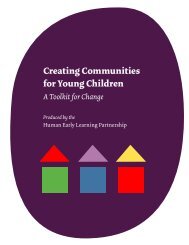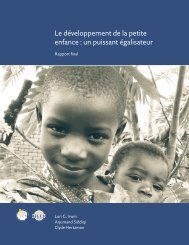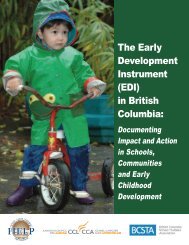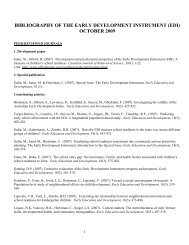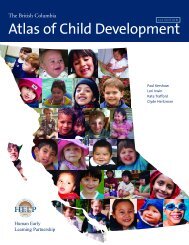Total Environment Assessment Model for Early Child Development
Total Environment Assessment Model for Early Child Development
Total Environment Assessment Model for Early Child Development
You also want an ePaper? Increase the reach of your titles
YUMPU automatically turns print PDFs into web optimized ePapers that Google loves.
Spheres of<br />
Influence:<br />
The Family<br />
Other studies have focused on relational<br />
qualities within families as measures of risk<br />
<strong>for</strong> adverse children’s outcomes. A recent<br />
review of research demonstrates an association<br />
between families which experience<br />
heightened levels of conflict and aggression<br />
and those that are characterized by cold,<br />
unsupportive, and neglectful relationships<br />
with a variety of outcomes in children,<br />
ranging from physical health outcomes and<br />
risky health behaviors, to emotional and<br />
social well-being [52, 61].<br />
the role of fathers<br />
The role of fathers as part of the family-level<br />
sphere should not be underestimated, and is<br />
often regrettably marginalized. The United<br />
Nations Commission on the Status of Women<br />
“…[encourages] men to participate fully in all<br />
actions towards gender equality and [urges]<br />
the establishment of the principle of shared<br />
power and responsibility between women<br />
and men at home, in the community, in the<br />
workplace, and in the wider national and<br />
international communities…” [62] Certainly,<br />
this includes the role of fathers in nurturing<br />
ecd of their children and those in their<br />
communities.<br />
There is also a substantial evidence base<br />
establishing the significant impact men<br />
have on children’s lives and well being, and<br />
a growing body of practice showing how<br />
working with men can be an important part<br />
of effective engagement with families. In fact,<br />
engaging with fathers and other men who<br />
affect the well being of children and families<br />
is now firmly emphasized in many policy<br />
frameworks as a strategic requirement <strong>for</strong> all<br />
children’s services [206].<br />
gender inequities within families<br />
Inequities within families may be significant<br />
from the standpoint of the social determinants<br />
of health, especially with respect to<br />
gender: “Women’s access to power at the<br />
household level has the most direct impact<br />
on families and children … [through lack<br />
of control over] allocation of resources <strong>for</strong><br />
food, health care, schooling and other family<br />
necessities” [19]. As a result, female children<br />
are more likely to receive less food, and to be<br />
denied essential health services and education.<br />
Household chores and caregiving keep<br />
adult women out of the paid labour <strong>for</strong>ce and<br />
girls out of school. Moreover, when mothers<br />
do work, female children are more likely to<br />
be kept home from school to care <strong>for</strong> other<br />
siblings, especially when there is no option<br />
<strong>for</strong> substitute caregivers such as childcare.<br />
Also according to the recent unicef report,<br />
Nearly 1 of every 5 girls who enrols in<br />
primary school in developing countries does<br />
not complete a primary education. Missing<br />
out on a primary education deprives a girl<br />
of the opportunity to develop to her full<br />
potential. Research has shown that educated<br />
women are less likely to die in childbirth;<br />
… are more likely to send their children to<br />
school; … [and] that the under five mortality<br />
rate falls by about half <strong>for</strong> mothers with<br />
primary school education. [19]<br />
It is clear that women’s roles (decisionmaking<br />
power) within the family, as well as<br />
their educational levels, play an important<br />
part in promoting ecd. Women’s education<br />
not only contributes to lower mortality rates,<br />
but also long-term education, <strong>for</strong> girls. Gender<br />
equity at the family level contributes to<br />
reducing the intergenerational transmission<br />
of poverty through improved development,<br />
access to education, and proper feeding [19].<br />
family dwelling<br />
The family dwelling also contributes to (or<br />
detracts from) nurture <strong>for</strong> children. The starkest<br />
representation of this comes from studies<br />
of homeless families and children which find<br />
much higher rates of physical and mental<br />
illness and worse developmental outcomes<br />
among this population [63]. This may be due<br />
to many factors, including the economic,<br />
social, and service resources that are directly<br />
or indirectly related to having a home.<br />
Of course, not all homes are equally as nurturing.<br />
Countless studies from resource-rich<br />
nations have demonstrated that high levels<br />
of lead (which are overwhelmingly clustered<br />
in low-income housing) are associated with<br />
multiple adverse developmental outcomes in<br />
children, most notably asthma [64].<br />
32



